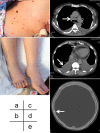TAFRO syndrome with refractory thrombocytopenia responding to tocilizumab and romiplostim: a case report
- PMID: 29468524
- PMCID: PMC5886949
- DOI: 10.1007/s13730-018-0319-0
TAFRO syndrome with refractory thrombocytopenia responding to tocilizumab and romiplostim: a case report
Abstract
Thrombocytopenia, anasarca, fever, reticulin fibrosis, organomegaly (TAFRO) syndrome is a unique clinicopathologic subtype of multicentric Castleman's disease that has recently been identified in Japan. However, little is known about its renal histological changes and the optimal treatment for TAFRO syndrome. An 80-year-old Japanese woman was admitted to our hospital for evaluation of severe anasarca and weight gain (10 kg in a month). She had polyneuropathy, monoclonal plasma cell proliferative disorder with positive kappa M-protein, a sclerotic bone lesion, elevation of vascular endothelial growth factor (VEGF), skin changes, and extravascular volume overload, which fulfilled the diagnostic criteria for POEMS (polyneuropathy, organomegaly, endocrinopathy, and monoclonal protein, skin changes) syndrome. However, kappa-type M-protein and thrombocytopenia with positivity of platelet-associated immunoglobulin G antibody were unusual, and fitted the diagnostic criteria for TAFRO syndrome. Renal biopsy showed diffuse endocapillary proliferative glomerulonephritis with endothelial swelling and the infiltration of monocytes and neutrophils without specific immunoglobulin deposits. Her systemic symptoms were refractory to initial treatment with high-dose melphalan and glucocorticoids. Alternative therapy with an anti-interleukin-6 (IL-6) receptor antibody (tocilizumab) effectively controlled the symptoms, while a thrombopoietin receptor agonist (romiplostim) was effective for her thrombocytopenia. Results suggest that IL-6-VEGF axis and an autoimmune mechanism may be responsible for TAFRO syndrome with clinical features of POEMS and refractory thrombocytopenia, which can be successfully treated with combination of tocilizumab and romiplostim.
Keywords: Multicentric Castleman’s disease; POEMS syndrome; Romiplostim; TAFRO syndrome; Tocilizumab.
Conflict of interest statement
Conflict of interest
The authors declare that they have no competing interests.
Research involving human participants and/or animals
This article does not contain studies with human or animal participants.
Informed consent
Written informed consent was obtained from the patient for publication of this case report.
Figures



References
LinkOut - more resources
Full Text Sources
Other Literature Sources

